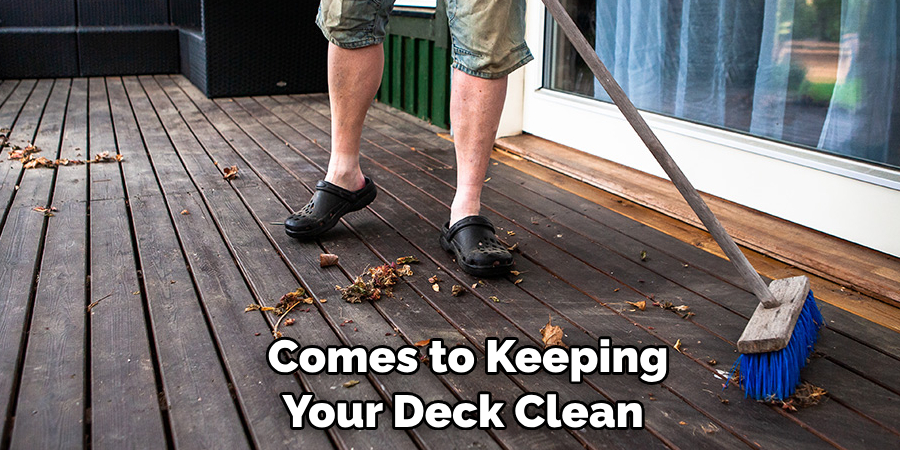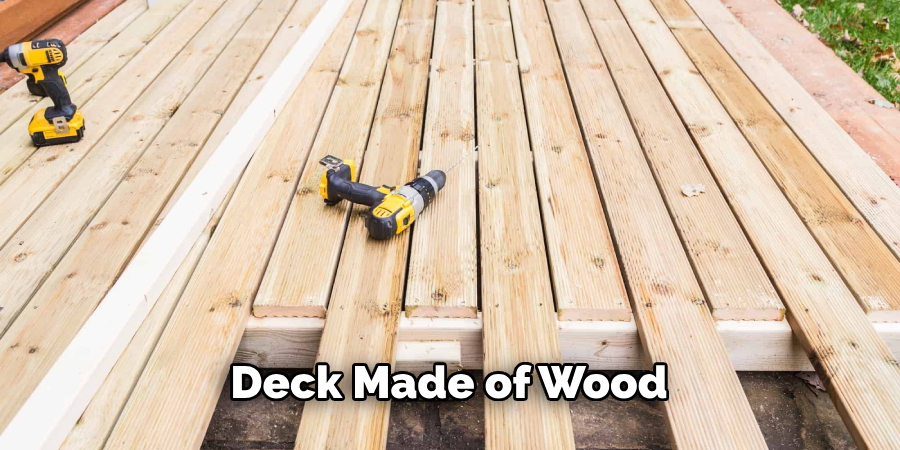Are you sick of having pesky raccoons invade your deck and make a mess of your outdoor space? Raccoons can be cute and cuddly, but they can also be a nuisance when they rummage through your garbage, steal your pet’s food, and destroy your garden.
Fortunately, there are several steps you can take to raccoon-proof your deck and keep these furry critters at bay. In this blog post, we’ll share how to raccoon-proof your deck with some easy tips to help protect your deck from raccoons.

Can You Raccoon-Proof Your Deck?
Raccoons are wily creatures known for their ability to open containers, climb trees, and raid trash cans. So, it’s no surprise that they can be a menace to homeowners with decks. If you’ve ever had the displeasure of finding your outdoor furniture overturned or your grill ransacked, you know the frustration of dealing with raccoon damage.
The good news is that there are steps you can take to make your deck less attractive – and accessible – to these mischievous critters. From securing lids on garbage cans to trimming overhanging branches, raccoon-proofing your deck requires a bit of ingenuity and determination. With a little effort, you can protect your deck and enjoy your outdoor space without the headache of raccoon infestations.
Why Should You Raccoon-Proof Your Deck?
Raccoons are cute and intriguing creatures but can also be a nuisance. If you’re a homeowner with a deck, you may be wondering whether or not it’s necessary to raccoon-proof it. The answer is a resounding yes! Raccoons are notorious for making their way onto decks, which can lead to a variety of problems.
For one, they can cause damage to the structure of your deck by chewing on wood and wiring. Additionally, they can be a real pain when it comes to keeping your deck clean, as they often leave behind feces and trash. Raccoon-proofing your deck is the best way to protect it from these furry critters, so it’s worth considering if you want to enjoy your deck without any unwanted guests.

How to Raccoon-Proof Your Deck – in 7 Easy Steps
Step 1. Eliminate Food Sources
The first step in raccoon-proofing your deck is to eliminate any potential food sources. This includes securing your garbage cans, removing bird feeders, bringing pet food indoors at night, and cleaning up fallen fruit or nuts from trees near your deck. Raccoons are opportunistic feeders and will go wherever they can find a free meal.
Step 2. Install Motion-Activated Lights
Raccoons are nocturnal animals and are most active at night. Installing motion-activated lights around your deck deter raccoons from entering your property, as they prefer to stay hidden. Bright lights can also help scare away any raccoons that do venture onto your deck.
Step 3. Build a Fence
If you have a lot of raccoons in your area, you may want to consider building a fence around your deck. This will keep raccoons out and other critters like skunks and possums. A fence should be at least 6 feet high and buried at least a foot into the ground to prevent raccoons from digging underneath it.
Step 4. Use Repellents
There are several natural and chemical repellents available that can help keep raccoons away from your deck. Some homeowners use mothballs, cayenne pepper, or vinegar as homemade remedies, while others prefer store-bought deterrents that contain predator urine or capsaicin. Keep in mind that some repellents may be harmful to pets or humans, so read the label carefully before use.

Step 5. Cover Your Deck
Another simple solution to prevent raccoons from accessing your deck is to cover it with a tarp or netting. This will keep raccoons out and protect your deck from leaves, debris, and other outdoor elements. Make sure to secure the tarp or netting tightly to prevent raccoons from getting trapped underneath or tearing the fabric.
Step 6. Seal Off Access Points
Raccoons can fit through surprisingly small gaps and openings, so inspecting your deck for any potential access points is important. Look for cracks or holes in the foundation of the deck, missing shingles on the roof, or broken window screens. Fill or patch up any openings with caulk, mesh wire, or hardware cloth to prevent raccoons from entering.
Step 7. Hire Professional Help
If the tips above are not enough to keep raccoons away from your deck, you may need to call a professional wildlife specialist for assistance. They can provide more comprehensive solutions such as installing chimney caps, trapping and relocating raccoons, or using humane exclusion techniques to keep them away for good. This may require an initial investment, but it’s the best way to ensure that your deck is properly protected from future invasions.
That’s it! You’ve now learned seven tips on how to raccoon-proof your deck. With these steps, you can keep pesky critters away and enjoy your outdoor space in peace.
5 Considerations Things When You Need to Raccoon-Proof Your Deck
1. Deck Height
If your deck is low to the ground, it is more likely that a raccoon will be able to access it. Raccoons are excellent climbers and can easily scale a deck that is only a few feet off the ground. If possible, raise your deck up at least four feet off the ground to make it more difficult for raccoons to access.
2. Deck Material
The material of your deck can also impact its raccoon-proofing. A deck made of wood is more likely to be damaged by a raccoon than one made of composite materials. Raccoons have sharp claws that can easily tear through wood, so if you have a wooden deck, you will need to take extra measures to protect it.

3. Railing Height
The height of your deck railing will also affect its raccoon-proofing. A railing that is too low will allow a raccoon to easily climb over it, while a railing that is too high may make it difficult for you to use your deck. The ideal height for a railing is between 36 and 42 inches.
4. Gaps in The Railing
Gaps in your deck railing can be an easy entry point for raccoons. Make sure that there are no gaps or openings larger than four inches between the deck and the railing, as this will provide a pathway for the animal to make its way onto your deck.
5. Stairs Leading to The Deck
If your deck has stairs leading up to it, a raccoon may be able to use them to access your deck. To prevent this, make sure that there is at least one step between each stair tread and that the risers are at least four inches high. You may also want to consider adding a gate at the bottom of the stairs to make it more difficult for a raccoon to access your deck. By following these tips, you can ensure your deck is safe and secure from unwanted visitors!
Benefits of Raccoon-Proof Your Deck
Are you tired of waking up to see a mess on your deck caused by raccoons? Or have you noticed damage to your furniture and plants because of these curious critters? It might be time to invest in raccoon-proofing your deck. Not only will this save you from the annoyance and frustration of cleaning up after them, but it will also protect your property from destruction.
Raccoons are known to carry diseases, so keeping them away from your outdoor living space will also benefit your and your family’s health. Plus, raccoon-proofing your deck will give you peace of mind knowing that your belongings are safe and secure. It’s worth the investment for a hassle-free and enjoyable outdoor living experience.

Some Common Mistakes People Make When Trying to Raccoon-Proof Your Deck
Raccoon-proofing your deck can be tricky, but with the right knowledge, it can be easily accomplished. Unfortunately, many people make mistakes that leave their decks vulnerable to raccoon invasion. One common mistake people make is assuming that any temporary fix will work long-term. While these fixes may seem effective initially, raccoons are clever creatures that will eventually find a way around them.
Additionally, some people make the mistake of leaving pet food or birdseed out on the deck, which raccoons find irresistible. This only invites them to come back for more, possibly with some friends in tow. To successfully raccoon-proof your deck, it’s important to take the time to thoroughly assess any potential entry points and invest in long-term solutions.
What Type of Fencing Will Work to Deter Raccoons?
If you’re dealing with pesky raccoons in your yard, a good fencing solution can be a lifesaver. But what type of fencing will work best to deter raccoons? While no fencing is guaranteed to keep every raccoon out, there are some options that may be more effective than others.
For example, electric fencing is often a great choice for raccoon control, as the shock it delivers can be enough to dissuade even the most determined critters. Additionally, tall fencing with no footholds, like chain links or wooden fencing, can be effective in keeping raccoons out of your garden or trash cans. With a little bit of research and the right fencing solution, you can send those raccoons packing for good!
Conclusion
In summary, raccoons can be a real headache when they start to invade our outdoor living spaces. However, by following these simple steps, you can raccoon-proof your deck and prevent these critters from causing damage or getting into your food.
Remember to eliminate food sources, install motion-activated lights, build a fence, use repellents, and cover your deck to keep raccoons at bay. With a little bit of effort and persistence, you can enjoy your deck without worrying about raccoon intruders. Thanks for reading our post about how to raccoon-proof your deck.

